 |
 |
 |
 |
 |
 |
 |
 |
 |
 |
 |
 |
 |
| |
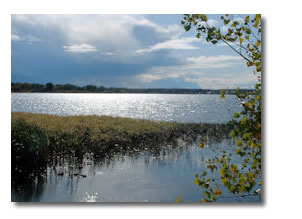 |
BRITANNIA AND THE POETS' PATHWAY
The Ottawa River is a fitting place to begin the Pathway.
Archibald Lampman and Duncan Campbell Scott travelled the Ottawa and Rideau rivers, the Gatineau and Lièvre rivers, and the Rideau Canal. They loved being immersed in nature, and Scott taught Lampman how to paddle a canoe. Sometimes William Wilfred Campbell joined them. Scott and Lampman spent a lot of time on the water, and wrote about the shore and the busy lumber scene, as well as the rivers, the hills and nature that surrounded them.
* The Ottawa River is the source of Ottawa’s power. Its name, its being chosen as capital of Canada, its early commerce and its wealth are all because of the river.
* Ottawa’s aboriginal peoples lived near its banks and travelled its length for centuries.
* Pauline Johnson, an aboriginal poet famous in her lifetime, and since, one of the Confederation Poets, read with Archibald Lampman in Ottawa in 1893. We have chosen one of her poems as the first for the Poets’ Pathway, honouring our first poets. |
|
 |
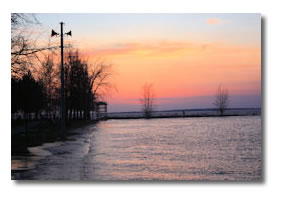 |
 |
 |
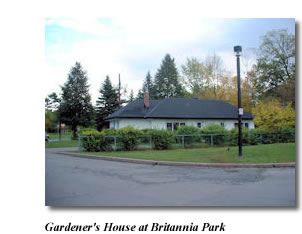 |
 |
Britannia Park
Britannia Park is a beautiful large park with a stone pier on the Ottawa River, in the west end of Ottawa. Green and lovely, with stunning sunsets spread out across the sky and water, it is the centre of many trails, home to Canada Geese, and to the Ottawa Folk Festival each summer. In summer the yachts from the Britannia Yacht Club dot its waters.
The park has a long sandy beach, play areas for children, a notable domed building for children’s hockey, tennis, long lawns, trees, parking, a picnic area. It is a popular area for outings, filled with families enjoying picnics, swimming, the sun and sand on warm weekends. The Lakeshore Pavilion houses many community activities.
The park has heritage attributes, as a trolley ran here for Sunday outings and the trolley station is still here, as are the Gardener's House (recently turned into a resident artist studio) and the G.B.Greene anchor. |
 |
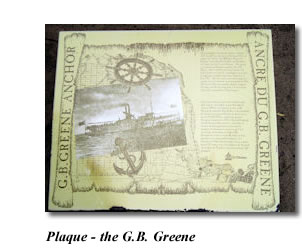 |
 |
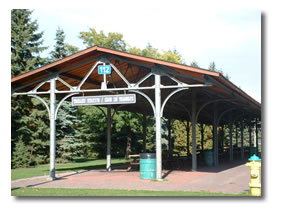 |
|
 |
The G.B. Greene
A double-decked side wheeler, the GB Greene, built for work on the Ottawa River, took passengers up the Ottawa River on daily excursions. The boat was 145 feet long, had a gallery for crew, a restaurant for passengers, comfortable benches and chairs, and could hold 250 passengers. It picked up passengers from both sides of the river and took them to Chats Falls, and after a two-hour picnic break brought them back home again. The boat caught fire, and although it was rebuilt, it was dismantled in1946. The anchor, however, is at the Britannia Yacht Club today.
|
|
 |
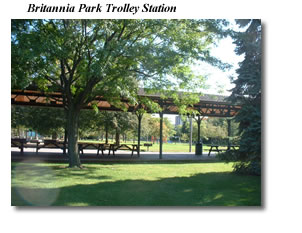 |
 |
Some History of Britannia Park
• John Lebreton acquired the land near the Chaudière, now known as Lebreton Flats, in 1819. He also bought land, named it Britannia, and erected a grist mill and a saw mill.
• The park was first developed in 1893 when the Ottawa Electric Railway Company decided to establish a new park on the Ottawa River. An auditorium was moved from Victoria Park. Opening day was May 15, 1900.
• The park grew and eventually became a summer resort. An illuminated pier was built in 1901. A boat club built at the end of this pier became famous as the home base for many winning Canadian rowers and paddlers, one of whom was the Olympic champion, Frank Amyot. There was a trophy-lined dance pavilion. The original club house unfortunately burned in 1917.
• Paddle steamers both, the "Albert" supplied ferry service to and from Fitzroy Harbour, and the "G.B. Greene" gave moonlight cruises with dancing on Lake Deschênes. Later the bell and ship's wheel of the G.B. Greene were saved. They are on display at the nearby Britannia Yacht Club.
• The first motion pictures in the area were featured at Britannia. A sheet was placed across the pier entrance to the park and images were projected onto it. As well, there was an open-air live theatre to entertain patrons.
• During the 1950s and into the 1960s, a small steam train ride entertained visitors to the park. Streetcar service in Ottawa ended in the spring of 1959 and was replaced with bus service. The old streetcar shelter is still standing.
|
 |
Aboriginals and Britannia
The Algonquins occupied the banks of the river long before Europeans arrived. An Indian trail existed between Lake Deschênes and Black Rapids on the Rideau.
Aboriginals lived also on the north bank, across from Britannia at Aylmer. Ottawa is situated on land traditionally owned by the Algonquin nation.
Part of the Indian trail can be seen today, a little winding trail through the white pines at the entrance to Pinecrest Cemetery. There is a stone monument to the trail there, erected by Pinecrest Cemetery: the monument marks the old Indian trail between Black Rapids and Lake Deschêne.
|
|
 |
 |
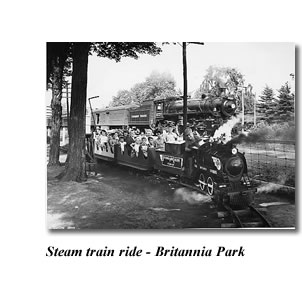 |
 |
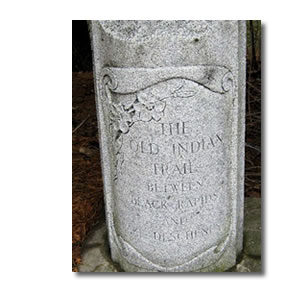 |
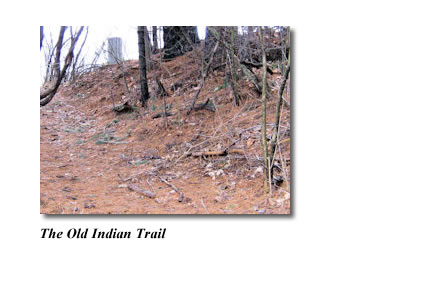 |
 |
 |
Mud Lake
Lovely Mud Lake, a nature lover’s and a birdwatcher’s destination, is just off the Poets’ Pathway, east of Britannia Park. It is a natural lake surrounded by forest and swamp, and is situated at the Deschênes Rapids. There is a path around the lake. Bicycles and dogs are not allowed on the path. Across from the lake is an escarpment, beside which are the Deschênes Rapids.
Mud Lake is bordered by the Ottawa River, Britannia and Cassel Streets. A National Capital Commission (NCC) bicycle path runs along the southern edge.
Hardwood forest, mature white pines, deciduous trees, ponds and swamps mean a variety of attractive habitat for animals, birds and plants. Midland painted and snapping turtles, many songbirds, and water birds, such as Great Blue Heron, blue and green-winged teal, and wood ducks are found here. Of course, squirrels and chipmunks join the throng.
|
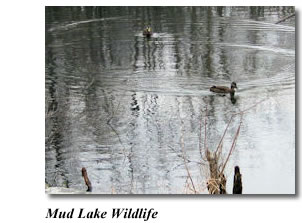 |
 |
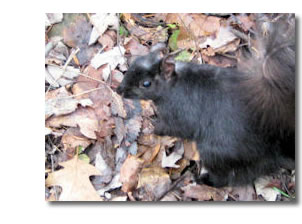 |
 |
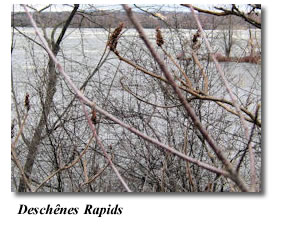 |
 |
 |
 |
TO THE OTTAWA
by Archibald Lampman
Dear dark-brown waters full of all the stain
Of sombre spruce-woods and the forest fens,
Laden with sound from far-off northern glens
Where winds and craggy cataracts complain,
Voices of streams and mountain pines astrain,
The pines that brood above the roaring foam
Of La Montagne or Des Erables; thine home
Is distant yet, a shelter far to gain.
Aye still to eastward, past the shadowy lake
And the long slopes of Rigaud toward the sun,
The mightier stream, thy comrade, waits for thee,
The beryl waters that espouse and take
Thine in their deep embrace, and bear thee on
In that great bridal journey to the sea. |
|
 |
In Lampman’s Time
- Before 1890 there were ten or so cottages in Britannia.
- Some people lived there only in the summer, and Archibald Lampman stayed occasionally.
- Lampman wrote letters from Lac des Chênes.
- In 1892 Britannia had 40 cottages, and some hotels, and civil servants, lawyers, merchants, a publisher, a jeweller, a dentist, and a druggist lived there.
- Access to Britannia was by train, bicycle or horse and carriage.
- The CPR had a station there.
|
 |
The Chaudière. A Scene on the River Ottawa
by Evan McColl
Where the Ottawa pours its magnificent tide
Through forests primæval, dark-waving and wide,
There’s a scene which for grandeur has scarcely a peer—
’Tis the wild roaring rush of the mighty Chaudière.
Though for lips uninspired it seems almost a crime
To be aught else than mute near a scene so sublime,
Could I voice all I feel as I gaze on it here,
How immortal in song were the mighty Chaudière! |
|
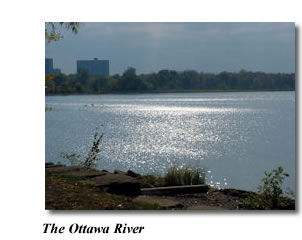 |
 |
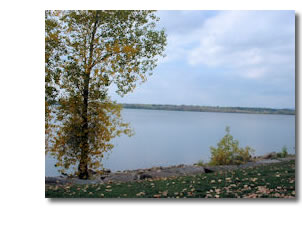 |
 |
Names of the Ottawa River
Champlain referred to the river as La riviere des Algoumequins.
After the Iroquois had driven the Algonquins out of the Ottawa Valley, the Outaouais Indians from the upper Lake Huron- Lake Michigan region became the predominant Indian fur traders traveling the Ottawa River. From their name, (in Algonquian language ‘to trade’), which was written in many forms, came the eventual name of the river. Among its names were: La Grande Rivière, Outaouais, Utawas, The Grand, The Kitchissippi.
|
 |
The Ottawa River
The Ottawa River, 800 miles in length, is the highway to a continent. Great flotillas of canoes, sometimes with hundreds of Indian and French paddlers and traders, travelled the Ottawa. Also traveling the river were missionaries, explorers, coureurs de bois, lumbermen, scientists and settlers. Champlain made the first map of part of the upper Ottawa River in 1613.
• The source of the Ottawa is Lake Capimichigama, 155 miles north of Ottawa.
• It passes through lakes and falls dropping 610 feet in its 300-mile westward course to Lake Timiskaming; drops another 85 feet to the Mattawa—another 365 feet during its east and south flow to Ottawa – then drops another 65 feet from the Chaudiere to Lake of Two Mountains.
• Upstream from the Chaudière Falls are the Little Chaudiere Rapids, opposite Val Tétreau, Remic Rapids at the Champlain Bridge, Deschênes Rapids entering Lac des Chênes. After the 26 miles of Lake Deschênes are the dangerous Chats Falls – rapids over rocks – 2 miles, 2 ½ miles wide.
Many of the awe-inspiring rapids and falls of the Ottawa River were objects of superstition. This is Champlain’s description of a native ceremony at Chaudière Falls:
‘after carrying their canoes to the foot of the falls, they assemble at one place, and one of them takes up a collection – each one places a piece of tobacco on the plate – the plate is placed in the middle, and all dance about it, singing, then one of the chiefs makes a speech, saying that for a long time they have been making this offering, and that by this means they are protected from their enemies… the speaker throws the tobacco into the middle of la chaudière, and they make a great cry all together.’
Champlain named the falls, which he saw for the first time in 1613, ‘Saut de la chaudiere.’ This is his description:
‘ the water falls… with such impetuosity on a rock that with the passage of time it has hollowed out a wide deep basin… the water whirls to such an extent, and in the middle boils so vigorously,that the Indians call it Asticou, that is to say, a kettle. This waterfall makes such a noise in this basin that one can hear it from more than two leagues away.’
|
 |
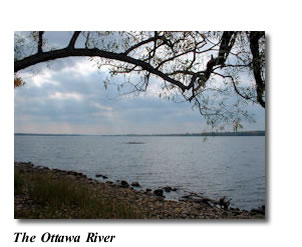 |
 |
 |
TO THE OTTAWA
by William Wilfred Campbell
OUT of the northern wastes, lands of winter and death,
Regions of ruin and age, spaces of solitude lost;
You wash and thunder and sweep,
And dream and sparkle and creep,
Turbulent, luminous, large,
Scion of thunder and frost.
Down past woodland and waste, lone as the haunting of
even,
Of shrivelled and wind-moaning night when Winter
hath wizened the world;
Down past hamlet and town,
By marshes, by forests that frown,
Brimming their desolate banks,
Your tides to the ocean are hurled. |
|
 |
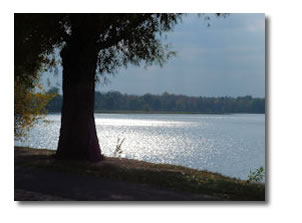 |
 |
 |
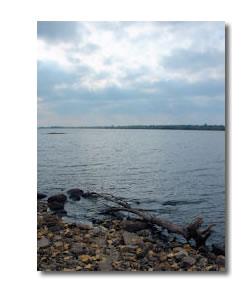 |
 |
THE SONG MY PADDLE SINGS
by E. Pauline Johnson
West wind, blow from your prairie nest,
Blow from the mountains, blow from the west
The sail is idle, the sailor too;
O! Wind of the west, we wait for you.
Blow, blow!
I have wooed you so,
But never a favour you bestow.
You rock your cradle the hills between,
But scorn to notice my white lateen.
I stow the sail, unship the mast:
I wooed you long but my wooing's past;
My paddle will lull you into rest.
O! drowsy wind of the drowsy west,
Sleep, sleep,
By your mountain steep,
Or down where the prairie grasses sweep!
Now fold in slumber your laggard wings,
For soft is the song my paddle sings.
August is laughing across the sky,
Laughing while paddle, canoe and I,
Drift, drift,
Where the hills uplift
On either side of the current swift.
The river rolls in its rocky bed;
My paddle is plying its way ahead;
Dip, dip,
While the water flip
In foam as over their breast we slip.
And oh, the river runs swifter now;
The eddies circle about my bow.
Swirl, swirl!
How the ripples curl
In many a dangerous pool awhirl!
And forward far the rapids roar,
Fretting their margin for evermore.
Dash, dash,
With a mighty crash,
They seethe, and boil, and bound, and splash.
Be strong, O paddle! be brave, canoe!
The reckless waves you must plunge into.
Reel, reel.
On your trembling keel,
But never a fear my craft will feel.
We've raced the rapid, we're far ahead!
The river slips through its silent bed.
Sway, sway,
As the bubbles spray
And fall in tinkling tunes away.
And up on the hills against the sky,
A fir tree rocking its lullaby,
Swings, swings,
Its emerald wings,
Swelling the song that my paddle sings. |
|
|
 |
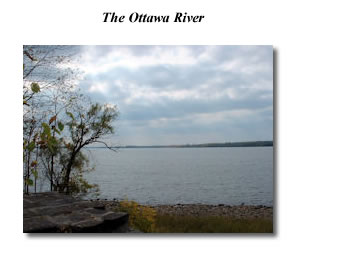 |
 |
| |
 |
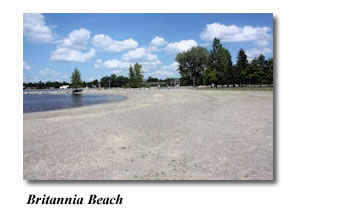 |
 |
| |
 |
| |
|
|
|
| |
|
| |
 |























